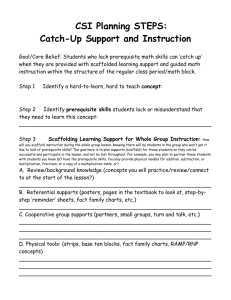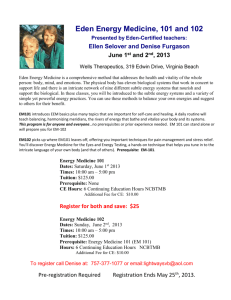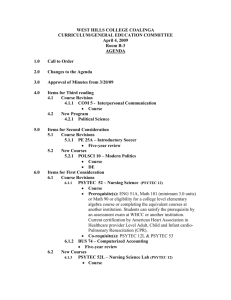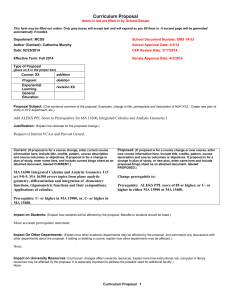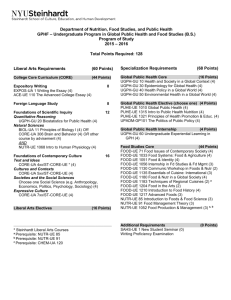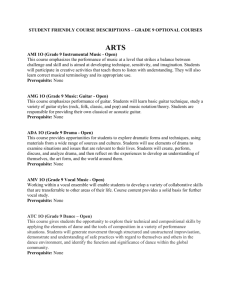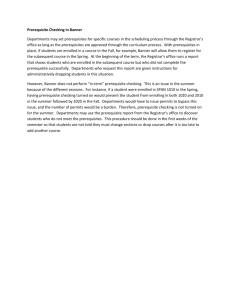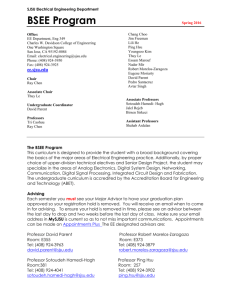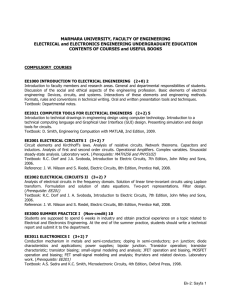Architectural Drawing Credit: 1 Prerequisite: DDP, or permission of
advertisement
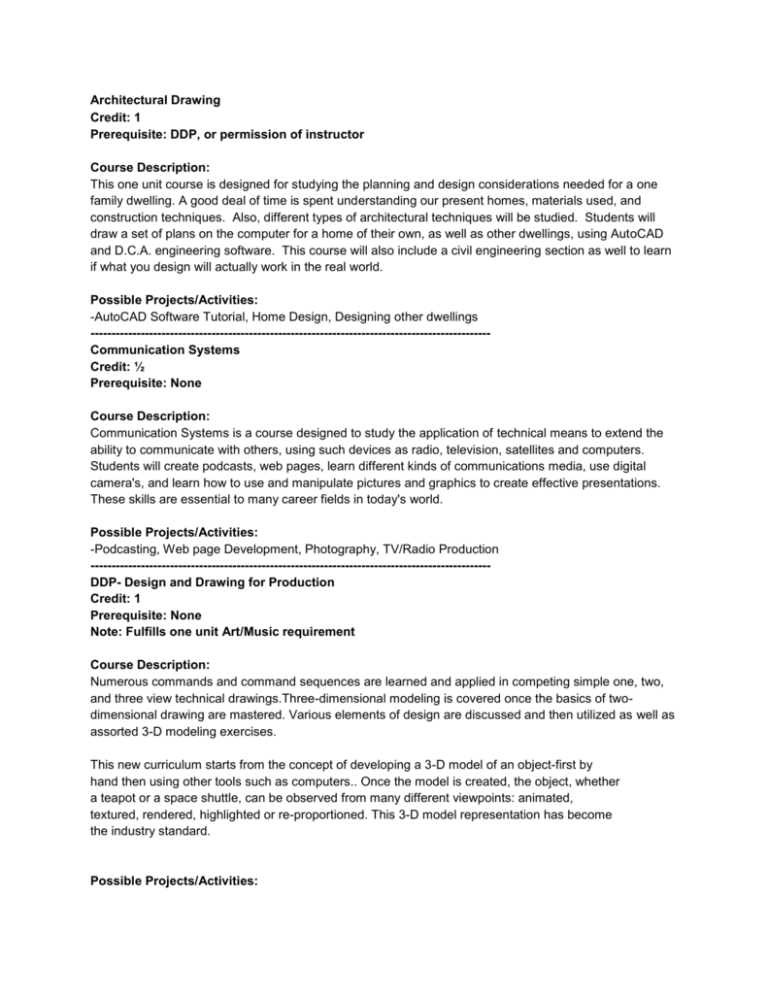
Architectural Drawing Credit: 1 Prerequisite: DDP, or permission of instructor Course Description: This one unit course is designed for studying the planning and design considerations needed for a one family dwelling. A good deal of time is spent understanding our present homes, materials used, and construction techniques. Also, different types of architectural techniques will be studied. Students will draw a set of plans on the computer for a home of their own, as well as other dwellings, using AutoCAD and D.C.A. engineering software. This course will also include a civil engineering section as well to learn if what you design will actually work in the real world. Possible Projects/Activities: -AutoCAD Software Tutorial, Home Design, Designing other dwellings -----------------------------------------------------------------------------------------------Communication Systems Credit: ½ Prerequisite: None Course Description: Communication Systems is a course designed to study the application of technical means to extend the ability to communicate with others, using such devices as radio, television, satellites and computers. Students will create podcasts, web pages, learn different kinds of communications media, use digital camera's, and learn how to use and manipulate pictures and graphics to create effective presentations. These skills are essential to many career fields in today's world. Possible Projects/Activities: -Podcasting, Web page Development, Photography, TV/Radio Production -----------------------------------------------------------------------------------------------DDP- Design and Drawing for Production Credit: 1 Prerequisite: None Note: Fulfills one unit Art/Music requirement Course Description: Numerous commands and command sequences are learned and applied in competing simple one, two, and three view technical drawings.Three-dimensional modeling is covered once the basics of twodimensional drawing are mastered. Various elements of design are discussed and then utilized as well as assorted 3-D modeling exercises. This new curriculum starts from the concept of developing a 3-D model of an object-first by hand then using other tools such as computers.. Once the model is created, the object, whether a teapot or a space shuttle, can be observed from many different viewpoints: animated, textured, rendered, highlighted or re-proportioned. This 3-D model representation has become the industry standard. Possible Projects/Activities: -Bridge Building (West Point bridge builder), Reverse Engineering: Students will measure an object and produce a 3-D CAD model of the part. Quality Control: Students will evaluate the quality of man-made objects, 3-D Modeling. Students will select a consumer product and trace the design changes over the history of the product and suggest future innovations. Students will design a model of an object made from “4x8” sheet of plywood (4x8 inch gray cardboard) using only six cuts(no waste allowed). Students will produce a computer generated model, set of working drawings, and a cardboard model. -----------------------------------------------------------------------------------------------Digital Electronics Credit: 1 Prerequisite: None Note: This course can be used as a substitute for the third year of math or science required of all students provided they have passed all required exams needed for graduation purposes. Course Description: Digital Electronics is a full year course designed to expose students to the terms and conditions of electronics in today's digital world. It begins with an overview and comparison of analog and digital fundamentals and terminology and the evolution of each. Next, students study the terms voltage, current, resistance, and power and how they interact in basic electrical and electronic circuits using Ohm's Law and the Power Law. Students then move into the concepts of digital electronics as they learn to use various number systems such as binary, decimal, hexadecimal, octal. They will learn to convert each type into the other and how they are used in modern electronic devices. Logic gates are introduced and students use Boolean algebra to analyze, describe, create, and simplify digital logic circuits. On the computer, students will use circuit simulation software to design and test digital circuitry. Students will then complete various lab experiments by setting up, wiring, testing, and troubleshooting these circuits using real components, breadboards, and test equipment. Possible Projects/Activities: -Simulate circuits using software, building basic digital circuits using integrated circuits as well as other electronic components, soldering basic circuit, electrical safety topics, new forms of digital electronics and how it has improved over the past 50 years -----------------------------------------------------------------------------------------------Photoshop Credit: ½ Prerequisite: None Course Description: Photoshop is a course where students study different parts of design and printing. This course will use a variety of projects, which allows the student to explore web and graphic design with a hands-on approach. Students will use computers and other digital medium to design and create projects using Adobe Photoshop. The world of printing will also be explored and the different methods of printing of materials that the students are familiar with such mediums as magazines, newspaper, etc. Students will be able to construct eye pleasing visual displays either for the print media or web. Recommended equipment: Digital Camera. Possible Projects/Activities -Create original imagery using industry standard technologies, Create original animation using industry standard technologies, Explain the input, process, and output model as related to digital multimedia, Know the appropriate use of types of graphics, animations, and interactive states, Recognize the use of the different types media taught in the course, Input imagery through: scanning, digital photos, downloading (e- mail, disc...), drawing, Process imagery using a graphics editor, Output imagery through: Print, Video, Internet, CD, DVD, Interactive DVD or CD-Rom -----------------------------------------------------------------------------------------------Principles of Engineering Credit: 1 Prerequisite: DDP or approval by course instructor Note: This course can be used as a substitute for the third year of math or science required of all students provided they have passed all required exams needed for graduation purposes. Course Description: Principles of Engineering is a full year course designed to introduce students to the concepts and principles, skills and techniques, and attitudes common to the engineering field. Through short learning activities and a series of real world case studies, students develop concepts in engineering design, modeling, systems, optimization, technology/society interaction, and engineering ethics.This course also develops a relationship between mathematics concepts, scientific principles, and technological practices in the completion of assigned tasks. Possible Projects/Activities: -Automobile Crash Test Study, Egg Crash Vehicle Activity, Real-world Problem Solving, Fuel Cells, Solar Powered Products -----------------------------------------------------------------------------------------------Residential Structures Credit: 1 Prerequisite: None Course Description: This course is designed to provide students with a general understanding of the materials and processes used in constructing and designing residential structures. This course was created predominately as a hands on course where students will gain knowledge through direct contact with materials and processes commonly used in the construction of new homes. Students will work on projects such as; constructing scale models of house framing, constructing a storage shed, and working on mock wall sections where students will utilize techniques for installing, plumbing, insulation, electrical work, sheet-rock, hanging doors and windows, and installing cabinetry. Students will also explore the history of residential structures, and investigate job opportunities and career training options that are available in the field of residential construction. Possible Projects/Activities: -Safely use power tools, Build small project to to take home (bird house, picture frame, etc...), Learn to estimate building material cost, Blueprint Reading, Basic electrical work (outlets, lights, ceiling fans, etc...), Residential plumbing (copper, plastic, valves, sink repair, etc...), Roofing, Deck and porch construction, Culminating project: Build a small building -----------------------------------------------------------------------------------------------Transportation Systems Credit: ½ Prerequisite: None Course Description: In this class, students come to realize the importance of transportation as they explore land, water, air, and space travel. They experience the excitement of building and testing a vehicle to study each mode of transportation. Students are exposed to cross country trips, using a road atlas to plan a trip. In a small gas engine module, students identify parts, disassemble and assemble the engine, learning basic components, functions and maintenance involved with a small gas engine. Possible Projects/Activities: -Building a hovercraft, Small Engine Tear-down/Rebuild, Model Airplane Building -----------------------------------------------------------------------------------------------Video Production Credit: ½ Prerequisite: None Course Description: Students will create short video clips by editing sound and video from multiple sources. The goal of this course is to teach students a wide variety of aspects that are involved with video production. By the end of this course, students will be familiar with various kinds of production formats such as biography, news story, short movie, and more. Students will also learn how to operate video production equipment such as cameras and editing software. Possible Projects/Activities: -Editing, Sound, Careers in Video Production, Software and Equipment Tutorial, Story Design, Script Writing, Commercials, Weekly News-Local Coverage, Current Events-National Coverage, Public Service Announcement, People at Work, Mini-Drama, Campus Story, Mood Piece, Music Video
